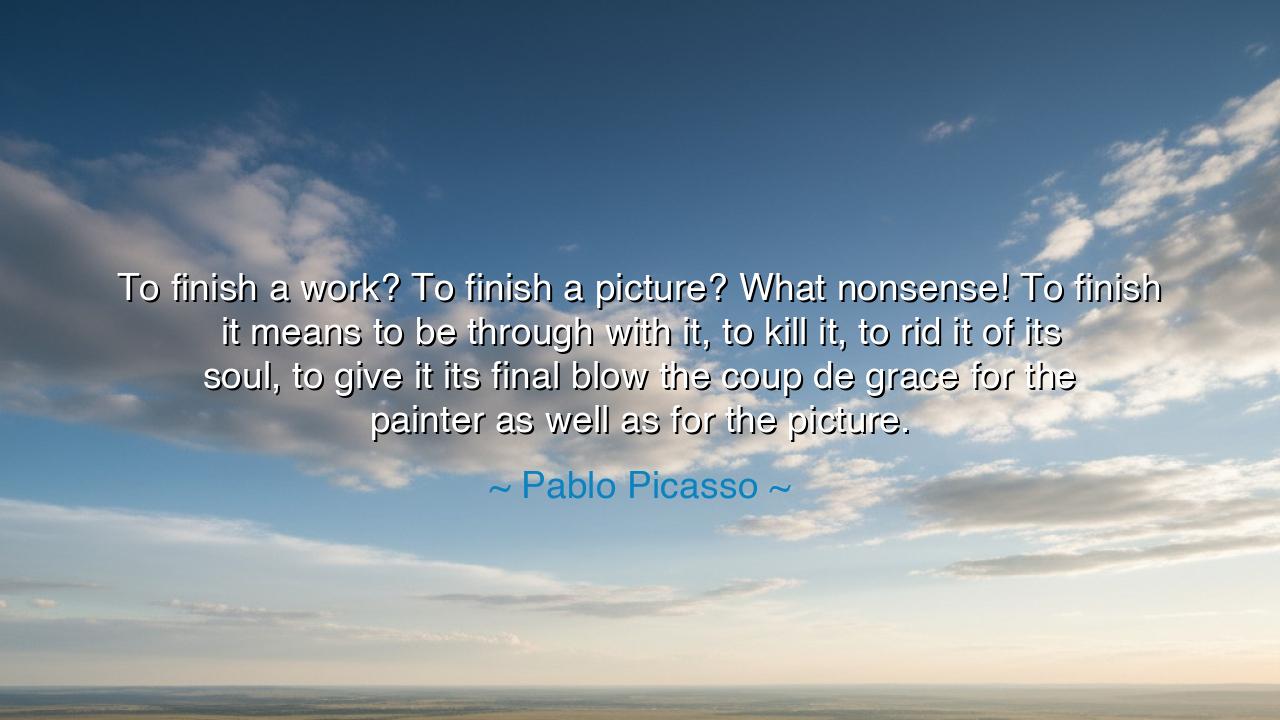
To finish a work? To finish a picture? What nonsense! To finish
To finish a work? To finish a picture? What nonsense! To finish it means to be through with it, to kill it, to rid it of its soul, to give it its final blow the coup de grace for the painter as well as for the picture.






When Pablo Picasso declares, “To finish a work? To finish a picture? What nonsense! To finish it means to be through with it, to kill it, to rid it of its soul, to give it its final blow — the coup de grâce for the painter as well as for the picture,” he speaks with the passion of one who understood creation as a living force. His words remind us that true art is never fixed or complete, but forever unfolding, breathing with the spirit of its maker. To call a piece “finished” is to deny its vitality, to treat it as an object rather than a living conversation.
The origin of this wisdom lies in Picasso’s own restless genius. Known for reshaping form, shattering tradition, and reinventing vision, he could never accept the idea of work as static. For him, each picture was not a destination but a process — an eternal becoming, where each brushstroke opened new possibilities. In this way, the act of calling something “finished” felt to him like death, the silencing of a voice still speaking.
To say that completion “kills” a picture is to reveal the paradox of creativity: that what is alive resists closure. The soul of a painting is not in its perfection, but in its striving, its movement, its flaws, and its surprises. Just as life itself is never complete until it ceases, so too is the work of art alive only so long as it resists finality. Picasso teaches that the artist’s bond with his creation is ongoing, never fully severed by a claim of completion.
His words also carry a rebuke to those who seek only polish and finality. In a world obsessed with product, Picasso defends process. The true painter is not one who delivers a sealed object, but one who enters into dialogue with the canvas, listening to what it demands, and knowing that no end can contain its infinite potential.
Let the generations remember: creation is not about arriving at an end, but about sustaining the dance between vision and form. Pablo Picasso’s words endure as a testament that art, like life, holds its soul only so long as it is allowed to breathe, to change, and to remain unfinished.






LTHuynh Thi Le Tuyen
Picasso’s viewpoint on finishing art is both provocative and liberating. It suggests that the true beauty of a painting lies in its constant evolution, but I wonder—how does this approach affect an artist’s relationship with their audience? If a piece is never truly finished, can viewers ever fully appreciate it? Does this philosophy create a sense of distance between the artist and the observer, or does it invite them into the artist’s ongoing creative process?
TNThai Nguyen
Picasso’s thoughts on finishing a piece of art speak to the heart of artistic integrity. His concern seems to be about the idea of closure in art, where finality can detract from the vitality of a piece. But I wonder—if the artist never decides a work is finished, does it ever truly reach its full potential? Can leaving things unfinished lead to better art, or does it only leave room for doubt and indecision?
NNngoc nam
This quote from Picasso challenges the very notion of completion in the artistic process. The idea that finishing a work means killing it makes me think—how do artists navigate this tension between perfectionism and the natural flow of creation? At what point does the need for completion stifle creativity? Is there a point where a work is ‘done’ in the eyes of the artist, or is it always an unfinished journey?
QLquan le
I find Picasso’s take on the act of finishing art both intriguing and somewhat unsettling. His assertion that completing a picture is like giving it a ‘final blow’ raises the question—what is the true purpose of creating art if it’s always incomplete? Does this mean that art is about the process rather than the final product? Can artists ever feel satisfied with a piece if it’s never truly ‘done’?
VNNguyen Viet Nhat
Picasso’s view on finishing a work is striking, especially the idea that completing it means killing its essence. It’s an interesting perspective, but I wonder—if a painting is never truly finished, does that mean it’s impossible to ever truly communicate everything the artist intends? Can there be an acceptable balance between refinement and retaining that raw, evolving spirit that Picasso speaks about?